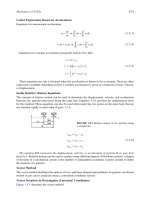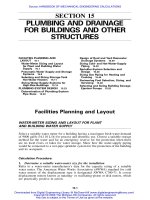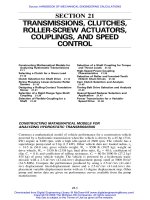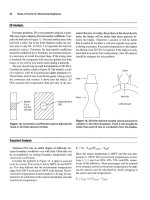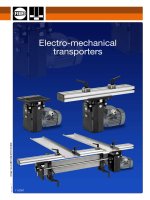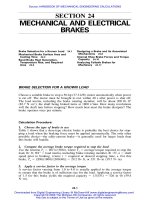Mechanical Vacuum Pumps docx
Bạn đang xem bản rút gọn của tài liệu. Xem và tải ngay bản đầy đủ của tài liệu tại đây (1.51 MB, 76 trang )
Andrew D Chew - Mechanical Pumps
“Vacuum in Accelerators” CERN Accelerator School May 2006
Mechanical Vacuum Pumps
Andrew Chew
CERN Accelerator School
Spain, May 2006
Andrew D Chew - Mechanical Pumps
“Vacuum in Accelerators” CERN Accelerator School May 2006
Disclaimer
The author and his employer, BOC Edwards,
disclaim any and all liability and any warranty
whatsoever relating to the practice, safety and
results of the information, procedures or their
applications described in this presentation.
Andrew D Chew - Mechanical Pumps
“Vacuum in Accelerators” CERN Accelerator School May 2006
Contents
- Vacuum basics: reminder
- Primary and secondary mechanical pump
technology
Andrew D Chew - Mechanical Pumps
“Vacuum in Accelerators” CERN Accelerator School May 2006
Gas Quantity
• Mass
• Number of molecules
• Moles
• Pressure/Volume units
– q = PV
– e.g. mbar liter/sec
– Could be expressed in joules
Andrew D Chew - Mechanical Pumps
“Vacuum in Accelerators” CERN Accelerator School May 2006
Quantity q
q = 100 mbar liter
1000 mbar
100 mbar
q = PV
PV n R T
w
M
RT
mo o
==
Given PV mass can be found
Given w q can be found
Only if we know
M and T
Andrew D Chew - Mechanical Pumps
“Vacuum in Accelerators” CERN Accelerator School May 2006
• Speed ≡ Volume rate
Speed = 1 liter/s
1000 mbar
1 mbar
SV≡
&
Speed
Andrew D Chew - Mechanical Pumps
“Vacuum in Accelerators” CERN Accelerator School May 2006
Speed curve example
0
50
100
150
200
250
300
0.001 0.01 0.1 1 10 100 1000
Pressure: mbar
Speed: m
3
h
-1
Andrew D Chew - Mechanical Pumps
“Vacuum in Accelerators” CERN Accelerator School May 2006
Throughput
1000 mbar l/s = throughput
1000 mbar
1 mbar 1 mbar l/s
• Throughput = Pressure x Volume rate
(where pressure is constant)
QPVPS==
&
Speed = 1 l/s
Andrew D Chew - Mechanical Pumps
“Vacuum in Accelerators” CERN Accelerator School May 2006
qPVw
RT
M
o
==
QPVw
RT
M
o
==
&
&
Quantity
Quantity/unit time
(Throughput)
Q tells us nothing about Pressure and Volume rate
separately - only the product
Throughput and Mass Flow
Andrew D Chew - Mechanical Pumps
“Vacuum in Accelerators” CERN Accelerator School May 2006
What do we mean by Speed?
• Manufacturers generally mean
– Volume flow rate measured under standard
conditions
– Generally units are:
m3/h, l/m or cfm for primary
and l/s for secondary
………….(many other units used)
– Gas inlet from a source at 20
o
C (standards
specify between 15
o
C and 25
o
C)
Andrew D Chew - Mechanical Pumps
“Vacuum in Accelerators” CERN Accelerator School May 2006
Displacement?
• Manufacturers generally mean:
– This is the swept volume rate D
i.e. the trapped or isolated inlet volume/unit time
– Maximum possible flow rate of the pump
– S < D
Andrew D Chew - Mechanical Pumps
“Vacuum in Accelerators” CERN Accelerator School May 2006
Rarefied gas and ranges of vacuum
Vacuum range mbar Pa
Rough 1013 - 1 10
5
-10
Fine/medium 1 - 10
-3
10
2
-10
-1
High 10
-3
-10
-7
10
-1
-10
-5
Ultra high (UHV) < 10
-7
<10
-5
Extreme high (XHV) <10
-10
/10
-11
<10
-8
/ 10
-9
Andrew D Chew - Mechanical Pumps
“Vacuum in Accelerators” CERN Accelerator School May 2006
Knudsen number:
Mean free path
Characteristic
dimension
Regime
ContinuumMolecular Transitional
Flow Regimes
Increasing Pressure
Typically < 10
-3
mbar Typically > 1 mbar
Kn =
λ
d
Andrew D Chew - Mechanical Pumps
“Vacuum in Accelerators” CERN Accelerator School May 2006
n, λ, and J at various P for N
2
at 293 K
P (mbar) n (m
-3
) λ J (cm
-2
s
-1
)
10
3
= 1 atm 2.5 x 10
25
6.6 x 10
-6
cm 2.9 x 10
23
1 2.5 x 10
22
6.6 x 10
-3
cm 2.9 x 10
20
10
-3
2.5 x 10
19
6.6 cm 2.9 x 10
17
10
-6
HV 2.5 x 10
16
66 m 2.9 x 10
14
10
-10
UHV 2.5 x 10
12
660 km 2.9 x 10
10
Andrew D Chew - Mechanical Pumps
“Vacuum in Accelerators” CERN Accelerator School May 2006
Flow Regime
Regime
MolecularContinuum
Kn<<1, λ <<d Kn>>1, λ>>d
molecule-molecule molecule-surface
collisions dominate collisions dominate
Andrew D Chew - Mechanical Pumps
“Vacuum in Accelerators” CERN Accelerator School May 2006
Continuum and molecular states
d here is a typical dimension (NOT molecular
diameter)
Kn < 0.01 Continuum state
0.01 < Kn < 1 Transitional state
Kn > 1 Molecular state
Knudsen number
d
λ
=Kn
Andrew D Chew - Mechanical Pumps
“Vacuum in Accelerators” CERN Accelerator School May 2006
Flow Regimes and Types
Regime
Type
Turbulent
Laminar
ContinuumMolecular Transitional
Re
Andrew D Chew - Mechanical Pumps
“Vacuum in Accelerators” CERN Accelerator School May 2006
Primary controlling parameter in the viscous
behaviour of Newtonian fluids
Re =
ρ
η
uD
h
LAMINAR
Re < 2000
TURBULENT
Re > 2000
Reynolds Number
Andrew D Chew - Mechanical Pumps
“Vacuum in Accelerators” CERN Accelerator School May 2006
C
1
C
2
C
Q
PP
ud
=
−
Definition:
Series
111
12
CCC
n
=++L
C
1
C
2
Parallel
C
n
= C
1
+ C
1
+
….
Conductance = 1/Resistance
Conductance
Andrew D Chew - Mechanical Pumps
“Vacuum in Accelerators” CERN Accelerator School May 2006
111
SSC
net
=+
Conductance Pump
C
S
Pumping speed can be combined with a
conductance in the same way as
conductances in series
Net Speed of a Pump
Note: In molecular flow
we need to introduce concept of transmission probability
Andrew D Chew - Mechanical Pumps
“Vacuum in Accelerators” CERN Accelerator School May 2006
111
SSC
net
=+
PS PS
S
S
K
unet d
net
=
=
QPS P PC
C
S
K
K
S
C
dud
=
=
−
∴
=
−
=+
()
1
1 or
Q
S
P
d
P
u
S
net
P
u
P
d
K =
C
From the definition of conductance
Speed, Pressure Ratio, Conductance
K is (zero flow)
compression ratio
Andrew D Chew - Mechanical Pumps
“Vacuum in Accelerators” CERN Accelerator School May 2006
Chamber Exhaust
dPV
dt
()
=0
V
dP
dt
P
dV
dt
PPe
S
V
t
=
−
0
t
V
S
P
P
=
⎛
⎝
⎜
⎞
⎠
⎟
ln
0
Andrew D Chew - Mechanical Pumps
“Vacuum in Accelerators” CERN Accelerator School May 2006
Mechanical pump types ( > 1 m
3
/h)
• Wet pumps
– Oil sealed rotary vane: Primary n = 0 to 3 (m
3
/h)
– Piston: Primary n = 0 to 2 (m
3
/h)
– Liquid Ring: Primary n = 1 to 3 (m
3
/h)
• Dry Pumps
– Northey-claw: Primary n = 1 to 3 (m
3
/h)
– Roots: Primary or Secondary n = 2 to 5 (m
3
/h)
– Scroll Primary n = 1 to 3 (m
3
/h)
– Screw Primary n = 1 to 3 (m
3
/h)
– Regenerative Primary n = 1 to 3 (m
3
/h)
– Piston Primary n = 1 to 2 (m
3
/h)
– Diaphragm Primary n = 0 to 2 (m
3
/h)
– Drag Primary or Secondary n = 0 to 2 (l/s)
– Turbomolecular Secondary n= 1 to 4 (l/s)
Primary pumps – exhaust to atmosphere
Secondary pump – exhaust to a backing (primary pump)
Max speeds shown exponent of maximum pump speed 10
n
(m
3
/h or l/s)
Andrew D Chew - Mechanical Pumps
“Vacuum in Accelerators” CERN Accelerator School May 2006
Operating principle
• All rely on principle of positive displacement of
gas (or vapour)
…… Except
– Drag pumps: which utilise molecular drag
– Turbomolecular pumps: capture technique
(exploits molecular flow phenomena)
Globally >> 500 000 made per annum
Andrew D Chew - Mechanical Pumps
“Vacuum in Accelerators” CERN Accelerator School May 2006
Choice of mechanical pump type….
Wet Pumps Dry Pumps
Capital Cost
Low High
Oil Loss
Can be high at > 1 mbar Very Low
System Contamination
Backstream at < 0.1 mbar
(1 part in 15 at ult)
Very Low
(
1 part in 10000 a
t
Add on Costs
Oil return/filtration Not necessary
Aggressive Process
Not suitable Resistant
Purge
Sometimes Almost always
Excellent detailed and in-depth of coverage in General
Literature and Manufacturers’ websites etc.


